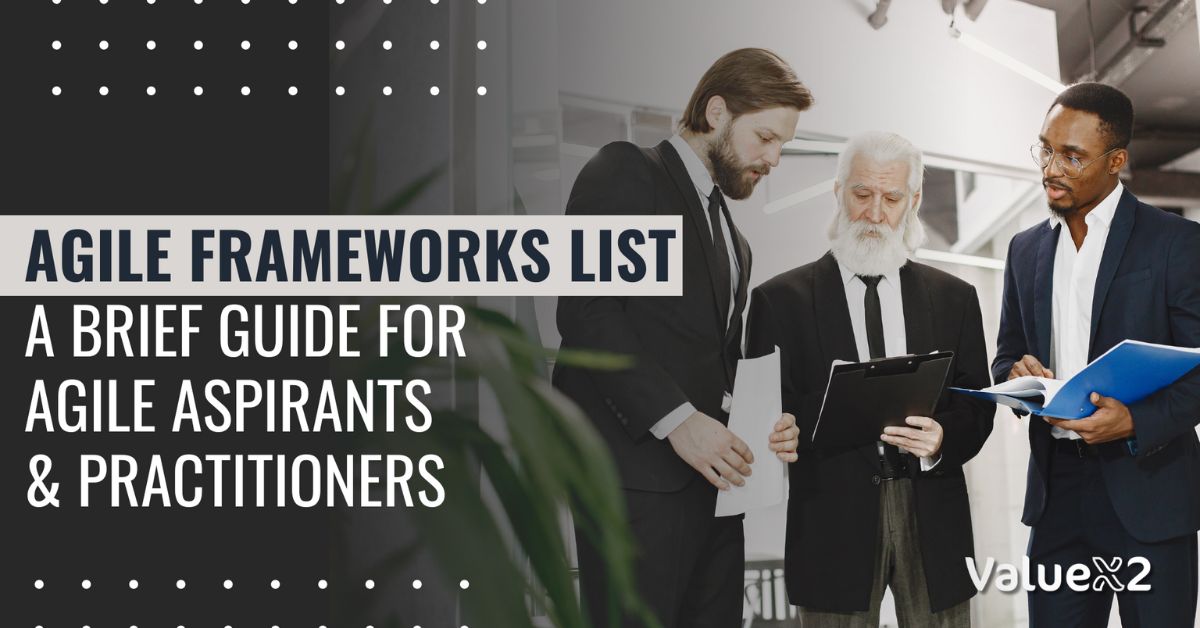Aspiring to adopt Agile practices? This guide will walk you through the key frameworks, helping you decide which might be the best fit for your team or organization.

Why Should You Know About Different Agile Frameworks?
Are you new to Agile or a seasoned practitioner? Understanding different Agile Frameworks can be incredibly beneficial. Every framework has its unique way of utilizing Agile principles personalized to fit your organizational needs. Once you know the ins and outs of these frameworks, you can make more informed decisions and enhance your team’s effectiveness. It does not matter whether you are in a small organization trying to keep things lean or in a large one that is scaling heights, there is a framework for you. Here at ValueX2, we have provided the most commonly used Agile frameworks.
Scrum: What Is it?
Scrum is the most known framework out there, and the most commonly used. Being simple and effective, it is widely used across industries. It is constructed around small teams that work together in cycles (sprints). This can last for as long as two to four weeks.
- Strengths: It has a structured approach that promotes teamwork and lets us improve on the value of delivery in a short period. Scrum is dynamic and adaptive; this is due to it having regular sprint reviews and retrospectives that record vast improvements.
- Potential issues: However, for you to cruise smoothly through it, you need to adhere to its principles and practices. This can be a problem for new teams and for those who prefer flexibility.
Kanban Vs Scrum
Both Scrum and Kanban share some similarities, though they are different according to how each handles work management. Kanban tends to picture work on a board to help manage the flow of tasks. Due to its flexibility, it can be used with the occurring processes to make it easy to adopt.
- Strengths: Kanban being flexible is a big flex, thus an advantage. Teams can decide to start on the current processes and advance gradually as they scale up.
- Weakness: Sprints are very important as they schedule the order of business to be done. Without the structure of sprints, teams may find difficulty in knowing task prioritization and deadlines.
Extreme Programming (XP): The Benefits
Extreme Programming (XP) is a framework that prioritizes continuous improvement and technical excellence to make your life easier. It would be appropriate to say that the user and the framework are in the same boat.
- Strengths: XP has some practices like pair programming and test-driven development that will ensure you maintain products of high quality.
- Potential Issues: For you to cruise smoothly as an XP user, you require a high skill level and discipline. Depending on the members of your teams, this may be challenging for some.
What Makes SAFe Stand Out?
SAFe the Scaled Agile Framework is designed for large enterprises that need to scale Agile across their teams. Large organizations with large numbers of teams.
Here are some of the courses involved with SAFe. Have a look at our training dates.
- Strength: SAFe offers you a structure that has clear roles and processes that align these large organizations towards a common goal.
- Potential Issues: Though SAFe may tend to carry out work effectively. its complexity may overwhelm the user. This is a reflection of analysis from smaller teams or those new to Agile.
How Does LeSS Scale Agile?
Large Scale Scrum (LeSS) is a framework that uses Scrum to extend over numerous teams working on the same product.
- Strengths: LeSS tries to keep Scrum simple as it facilitates effective teamwork.
- Potential Problems: For very large organizations, LeSS might not offer enough structure.
Understanding Disciplined Agile (DA)
With the help of a versatile toolbox called Disciplined Agile (DA), organizations can select techniques that best suit their requirements.
- Strengths: DA is flexible and covers a wide range of topics, including business operations and IT.
- Possible Problems: Teams who have a lot of options may find it difficult to be consistent, which could confuse them.
What’s Unique About Nexus?
Nexus is the type of framework that extends its Scrum principles and practices throughout the teams of the organization so that it can manage dependencies.
- Strength: This Framework adds roles and events to assist the involved teams in working together for the best results.
- Potential Issues: Nexus tends to be a bit complex, especially in larger organizations.
Get the Best Training on ValueX2
The frameworks mentioned in this article are just a handful of the most common frameworks. Do you want to learn more about these frameworks and how they can be applied to your daily life to make things better business-wise? ValueX2 has several courses you can partake in, get certified, and lead organizational change. Our in-depth training courses can assist you and your company in achieving success on your Agile journey.
Whether or not you have just started to scale up or you have been in the Agile universe and gained experience in it, these globally recognized Agile certifications cover all the necessary Agile frameworks and best practices.
FAQs
Q: Which Agile framework is best for beginners?
A: All frameworks are good, but that depends on your needs. Scrum is often recommended for beginners because of how it is simple and well-defined. It has features that help teams get a head start with Agile practices.
Q: Can I combine different Agile frameworks?
A: Indeed, a lot of businesses blend components from other frameworks to build a hybrid strategy that works best for them. For instance, XP techniques can be incorporated into a Scrum team to improve technical excellence, while the flexibility of Kanban can strengthen the structure of Scrum.
Q: Which are the most common Agile frameworks?
A: The most used frameworks are:
- Scrum
- Kanban
- Extreme Programming (XP)
- Feature Driven Development (FDD)
- Crystal
- Dynamic System Development Method (DSDM)
The frameworks above have been integrated to support teams in delivering value through continuously occurring processes and improvement.
Q: What are the four Key principles of Agile?
A: There are four most important principles of Agile. These are:
- People and their interactions rather than procedures and equipment.
- Functional software as opposed to extensive documentation.
- Client cooperation as opposed to contract drafting.
- Adapting to change as opposed to sticking to a plan.
The values above are common among all Agile methodologies. They tend to explain how Agile methodologies can help organizations be flexible, promote teamwork, and deliver quality to their customers.

Bhavna is an Agile Coach and Consultant with over a decade of experience in advisory, corporate finance, IT assurance, and operations at Big 4 and within the industry in the UK and India. She has recently been the CEO of a start-up where she implemented agile practices within HR, Marketing, and Product teams.
She is also a SAFe® Practice Consultant (SPC) and authorized instructor for ICAgile Agility in HR (ICP-AHR), Agility in Marketing (ICP-MKG), and Business Agility Foundations (ICP – BAF) training courses. She provides training for agile transformation to corporate, public, and private batches, as well as consulting for enterprise agile transformation.






